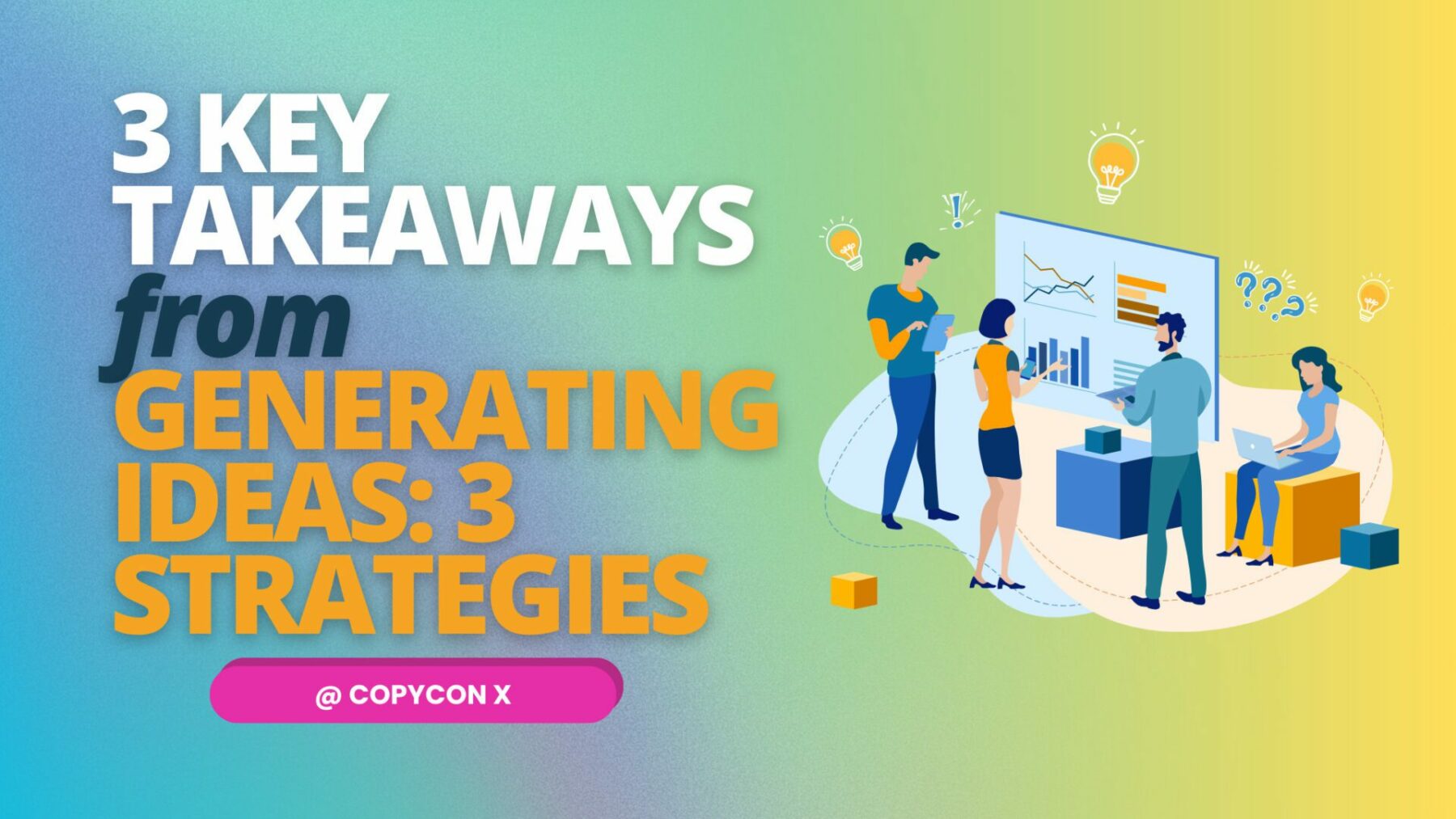Hi there! I’m Jennifer (or Jenny, or even Jen – I answer to all three!) and I am the new copywriter at the Munro Agency. To share a little bit about myself, I grew up in the beautiful Scottish Highlands before coming down to Glasgow for university. After a brief false start where I thought I wanted to be an astrophysicist, I made a complete 180-degree turn and actually graduated with a joint degree in Scottish and Comparative Literature.
As you might imagine, this means that I have spent vast amounts of time exploring words across many formats. One of my favourite courses at uni even delved into the intersection of text and images and explored how the two relate to each other.
Given my academic background, it was somewhat inevitable that I would make my way into copywriting and marketing. I’ve worked with other agencies and written content for clients and industries all around the world, and I’m excited to see what I can bring to the Munro Agency!
CopyCon X
Amongst training videos and onboarding tasks, Nhan invited me to check out the videos from CopyCon X, the UK’s biggest copywriting conference, which takes place in October each year. At 2023’s conference, they had a packed schedule of different talks and presentations from some of the best in the business. I watched the videos, picked up some great tips to apply to my writing, and then decided to focus on the insights gathered from just one of them.
Other speakers dazzled with insights into finding humour in anything, praising mediocrity, and asking ourselves simply what clients mean, but I was particularly taken with Tiffany Markman’s “Generating Ideas: 3 Strategies”.
As a copywriter, I’ve been faced many a time with the demand for on-the-spot creativity. Whether you are coming up with ideas for a blog or just brainstorming something for a new product, turning on the creative tap when needed can be a challenge!
You never know when you might be asked to come up with something, whether you work in the marketing department or elsewhere. Knowing a little strategy for how to approach idea generation means you are more likely to be able to offer something, anything, (good or bad; an idea is an idea) rather than be left with nothing but your latest earworm echoing around your head.
From Markman’s talk, I pulled three great takeaways (or maybe five since the last one can be split into three?). Each one challenges you to think about creativity in new ways and can help anyone to generate ideas.
Markman’s Golden Rule
Markman kicked things off with the introduction of one simple golden rule: either say something no one else has ever said OR say something unoriginal in an original way.
I think that this is a brilliant mindset for both creatives and wider businesses. It does not matter where you sit within a business, whether it is B2B or B2C, there is something invaluable to be learned here.
The American director and screenwriter Jim Jarmusch echoes what Markman is angling at with this quote: “Nothing is original. Steal from anywhere that resonates with inspiration or fuels your imagination. […] Select only things to steal from that speak directly to your soul. If you do this, your work (and theft) will be authentic. Authenticity is invaluable; originality is non-existent.”
Let’s be clear here; that doesn’t mean that you can go out and steal all of your main competitor’s branding and strategy just because no one has original thoughts anymore.
Instead, think about what you can do to stand out. Many B2B businesses offer similar products or services as competitors – especially in the realms of SaaS. That is just a fact. The business landscape would look rather boring if only one company was allowed to offer one particular service at a time.
If you can think of some truly weird and wonderful way to stand out from the crowd with your messaging, you can break away from any competitor sharing the spotlight with you.
Many of the best brands do exactly this. They look at the messaging that their competitors are using and then they do something completely out of pocket. When done effectively, this can completely transform the public’s perception of a brand. Don’t let worries about originality hold you back!
Grabbing Interest
Following on from this introduction of the Golden Rule, Markman spoke on the best ways of grabbing interest. Since we are speaking originally on unoriginal things, we need to at least make sure that what we say is interesting, right?
What do we find interesting? Well, that is completely subjective. I am interested in the crime fiction sub-genre Tartan Noir, but plenty of people out there would hate to pick up such a book.
However, there are some common markers in what we find interesting, no matter what the subject of our interest might be. Markman introduced these as:
- Humour
- Interactivity
- Story
- Passion
- Variety
- Analogy
By including at least one of these markers in your work, there is a good chance that you can capture and hold the attention of your audience, regardless of how “unoriginal” your concept might be.
Any good B2B business should look to focus its efforts around these pillars to attract interest. Some of these will naturally go hand in hand.
Passion and story are brilliant for narrating your business journey and discussing how you got to where you are today. Interactivity and variety can make your product demos sing. Analogy is perfect for explaining finer and more technical points. Humour in a tasteful amount can hit the spot across your messaging, from a cheeky pop-up on your website to a Fri-Yay update on your company’s social media.
Personally, I learn best through comparison and analogy (gotta use those comp lit skills somewhere, I guess). If I am faced with something new that I don’t yet understand, the faster I can come up with an analogy, the faster I’ll reach that lightbulb moment where I understand what is going on.
If a marketing campaign uses a fun little analogy to explain its product or service, I am more likely to engage with it! It has piqued my interest in a way that a competitor might not. When it comes to standing out from the crowd, it really can be that simple.
Generating Ideas
Of course, Markman’s focus for her presentation was on generating ideas. She broke this down into an overarching concept of micro-focusing on the subject at hand and provided three different strategies to help you do so.
Strategy One – The Shrink
Markman’s first strategy is to zoom in on the topic so far that you find that small thing in amongst the mess of potentials that you know could resonate with many. No matter who views the product or campaign, there will be a simple message that speaks to them.
This is a great way to neatly dance around the problem mentioned above – everyone is interested in different things. When you have that one thing that speaks to many people, you can build it into a fully-fledged persona ready to speak to the consumer.
Personas are nothing new in the world of marketing but, remember, we do not have to be original! Instead, we just need to think of an original way to bring the persona to life, and then most people can quickly generate a bank of ideas for content.
What could your business’s persona be getting up to at the weekends? What does their desk look like? What do they have for lunch? So many ideas may bloom that you could have difficulty cutting down on what you want to do.
Strategy Two – The Rabbit Hole
Markman’s second strategy speaks to me perfectly, and that is to head down the rabbit hole. Explore, research, and discover overlaps and connecting ideas that you might never have considered otherwise. We’ve all spent hours clicking through Wikipedia and reading as many articles as we can, so why not do it in the name of research?
Since no idea is original, there will be plenty of parallels to draw from. Likewise, we take inspiration from so many weird and wonderful places when creating. Why did you choose your specific name and branding for your business?
Take your inspiration and spend some time really delving into it, and don’t forget to explore the avenues around it too. There may be some fabulous connections waiting for you to discover them, which in return will lead you to a wealth of ideas.
Strategy Three – The Leap
Finally, Markman’s last strategy asked us to consider a simple question – what if?
With this simple question in hand, you have the opportunity to run off and explore the complete opposite of what you have been working towards thus far. Markman made sure to emphasise the point here that this strategy has all cards off the table (or as she put it, go batsh*t crazy).
As soon as you start pondering what if, you can so easily begin to generate ideas. Do not hold yourself back here, some of the best ideas out there have been born from these questions. I myself have sat down at my keyboard equipped with nothing but what if more times than I can remember, and it never takes long for the ideas to start flowing.
What have we learned?
Markman’s session provided some truly amazing insights into generating ideas. Understanding that no idea is original is such a freeing concept and it gives us plenty of wiggle room to sit down and generate ideas.
Some people approach this task with real worry, but Markman proves just how easy it can be. What do you need ideas for? Blog content? Your next product launch? Even branding for your business? With the three strategies above, it should be a piece of cake.
Remember, perfectionism is not the game here, so you can think up as many ideas as you like and then cut them down afterwards. Once you have that list, you can go in and begin to refine them and work out why they would precisely appeal to your target audience.
I learned so much from both this session and the others at CopyCon, and I can’t wait to put what I’ve learned into practice!










Leave a Comment